Asian buffalo leech
Hirudinaria manillensis (Lesson,1842)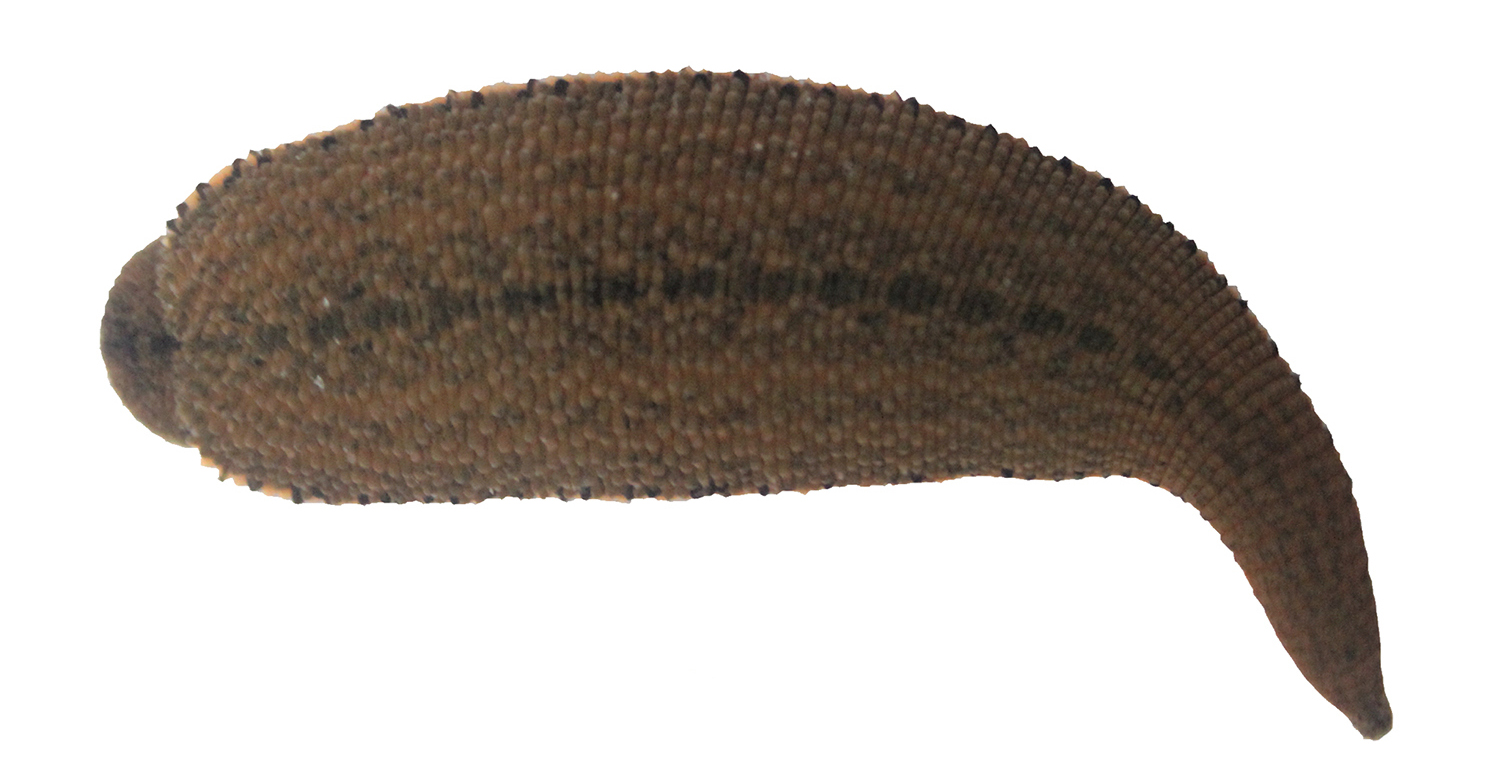 |
| Figure 1. Dorsal view of Hirudinaria manillensis. Retrieved from Tubtimon et al., 2014. |
Introduction
The Asian buffalo leech, also known as the asian medicinal leech, is commonly found in natural water bodies of the South East Asian region. Adults reach a maximum width of 13mm and length of 130 - 140 mm, and can stretch up to 200mm when fully extended [10]. They can be found in the Indo - West Pacific region within slow moving or stagnant waters, normally in rice paddies, swamps, and sluggish streams. In cattle rearing countries within the region, they are very frequently found attached onto the bellies of livestock, feeding on their blood [4]. They are known to feed on amphibians, reptiles, mammals, and - much less commonly - Telostei fishes in the wild [10]. There are currently no known predators of the Asian buffalo leech. Hirudinaria manillensis is currently exploited as a medicinal leech, and has in recent times replaced the European medicinal leech, Hirudo medicinalis, due to similar physiology and the conservation status of the latter [2]. The conservation status of the Asian buffalo leech itself has yet to be determined by the IUCN red list but is assumed to be inconsequential as of now. They are known hermaphrodites, and mating individuals are capable of reciprocal fertilisation [6]. Species epithet manillensis literally means 'from Manila', in reference to the capital city of the Philippines - from which the type specimen was collected.Taxonomy
Hirudo manillensis Lesson, 1842. Type locality: Philippines.Hirudo sanguisorba Tennent, 1859. Type locality: Sri Lanka
Hirudo multistriata Schmarda, 1861. Type locality: Sri Lanka
Hirudo luzoniae Kinberg, 1866. Type locality: Manila, Philippines.
Hirudo maculosa Grube, 1868. Type locality: Singapore
Hirudo maculata Baird, 1869. Type locality: Thailand
Limnatis (Poecilobdella) granulosa Blanchard, 1893. Type locality: Java, Indonesia
Hirudo boyntoni Wharton, 1913. Type locality: Philippines.
Limnatis maculosa - Dequal, 1917
Limnatis (Poecilobdella) manillensis - Moore, 1924
Hirudinaria manillensis - Moore, 1927
Higher classification
AnnelidaClitellata
Oligochaeta
Hirudinea
Arhynchobdellida
Hirudinidae
Hirudinaria Whitman, 1886
Hirudinaria manillensis (Lesson, 1842)
Original description
| Figure 2. Original description. Retrieved from Biodiversity Heritage Library. Originally published in Revue Zoologique par La Societe Cuvierienne, 1842. |
Description of a new leech species.
Leech of manila, Hirudo manillensis, Lesson - It attains a relatively large size, and varies from 4 to 5 inches and even more. Its body is formed from well marked segments that are quite close. Its underbody is olive green in colour, having an olive brown colour for a middle line, and some vermicular black winding features on its sides . The lower segment is large, uniformly black, and rising from each side along the body a relatively large border. The segments are lightly granulated, the sucker is large and the mouth is small.
This leech lives in the soft waters off the islands of Philippines, or maybe China. Several samples have been brought by Mr Pesrou, a surgery major of the frigate Magicienne, which sank off the seas of China in June 1841.
Barcode information
COX1 sequence from Genbank (NCBI) - GQ368746:TATATTTAATCTTAGGTGCTTGGGCTGCTATATTAGGATCCTCTATAAGTACTATTATCCGGGTT GAATTATCTCAGCCAGGTAGTTTTCTCGGAGACGATCAACTTTATAATTCCTTAATTACTGCACATGGAC TTATTATAATTTTCTTTATGGTAATACCTATTTTAATTGGAGGTTTTGGTAATTGACTTTTACCATTGAT AATTGGTGCGCCAGATATAGCTTTTCCTCGATTAAATAATTTTAGGTTTTGATTACTTCCACCATCATTA ACTATATTGGTAAGATCATCAATAGTTGAAAATGGTGTTGGTACAGGATGAACTATTTATCCACCATTAG CTGATAGTATTTCTCATTCAGGACCATGTGTGGATATAGCTATTTTTTCATTACATATAGCTGGTGCATC TTCTATTTTAGGTTCTTTAAATTTTATTTCTACTATTGTTAATATACGAACTAATGGAATAGGAAATGAA CGAGTTCCATTATTTGTTTGATCTGTAGTAATTACTACTATTTTATTACTACTATCATTACCAGTATTAG CAGCAGCTATTACAATATTTTTAACTGACCGTAATTTAAATACTTC
Distribution
Hirudinaria manillensis is native to the Indo - West pacific region, and has been reported in Philippines, Indonesia, Bangladesh, Sri Lanka, China, Taiwan, Malaysia, Thailand, and Singapore [9]. A recent publication by Philips A. (2012) [7] also confirmed the presence of Hirudinaria manillensis in the caribbean due to anthropogenic dispersal.Within Singapore, the leeches are mostly found in relatively less disturbed areas like waterlogged swamps or streams around and within the Central Catchment Nature Reserve, Nee Soon Swamp Forest, Bukit Timah Nature Reserve, and Mandai reservoir. On-going research is still discovering the distribution of Hirudinaria manillensis within Singapore.
Identification
Adults range from 130 - 140mm, with width of 10 - 13mm. Dorsally, they are dark brown in colour with a middle dorsal line that is distinct, black, and discontinuous. Its body margin is yellow, but disrupted with black spots (Figure 3). Hirudinaria manillensis possess a trignathous jaw (Figures 4 & 5) with approximately 148 teeth per jaw, which can be found atop each jaw. They possess 5 pairs of eyes, positioned in a concaved manner at the anterior end (Figure 6). The male and female gonopores are separated by 5 annuli, as illustrated in Figure 6. Figure 7 shows the male reproductive system located in the middle of the body between somites XI and XII, as well as 11 pairs of moderately small testisacs at XIII/XIV - XXIII/XXIV. Vaginal caecum present [9][10].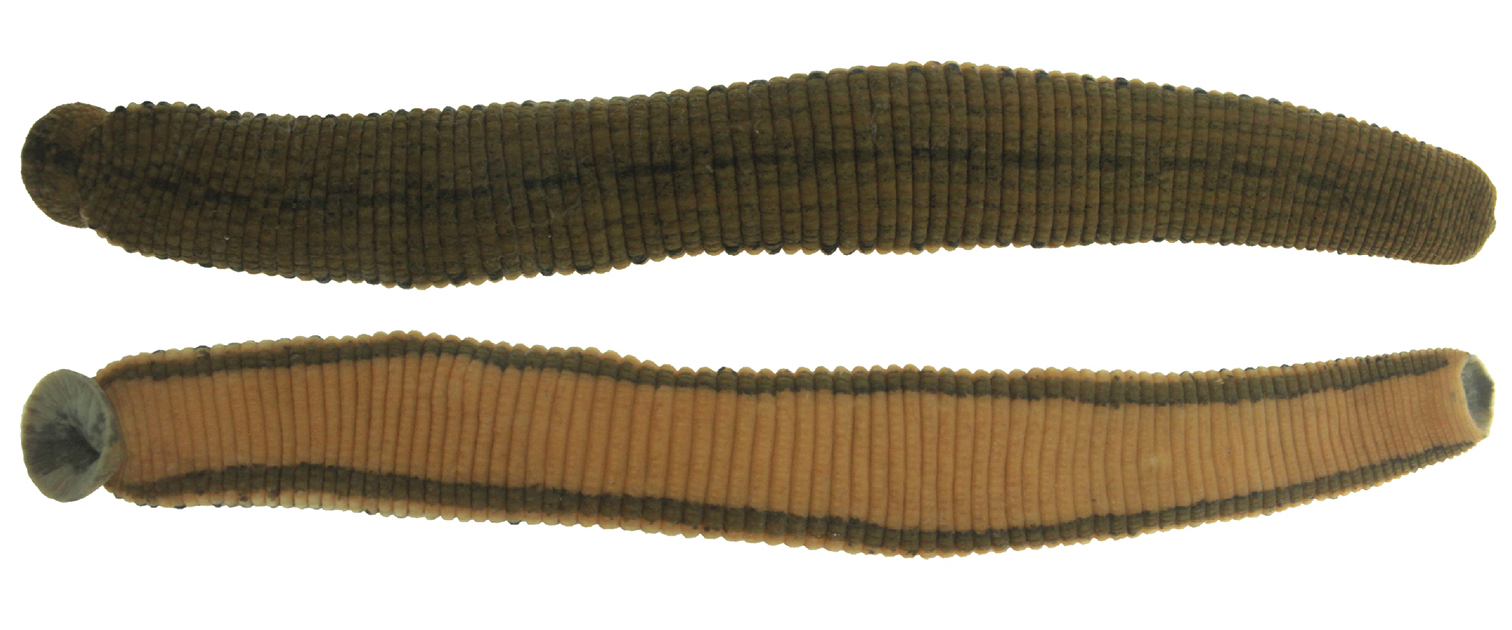 |
| Figure 3. Dorsal and ventral view of Hirudinaria manillensis, fully extended. Retrieved from Tubtimon et al., 2014. |
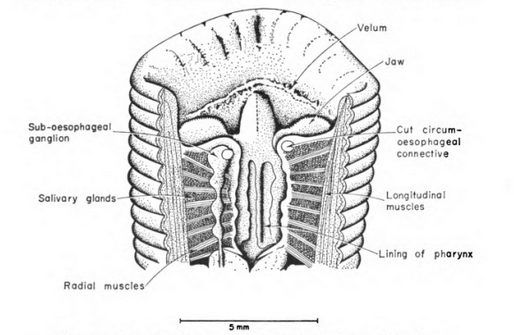 |
| Figure 4. Illustration of typical Hirudinidae anterior. Retrieved from Mann, 1962. |
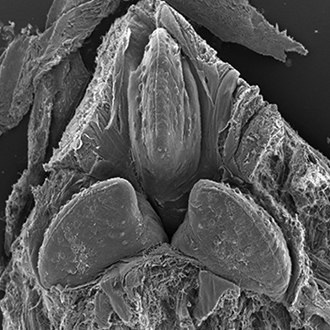 |
| Figure 5. Scanning Electron Microscope image of Hirudinaria manillensis jaw. Retrieved from Tubtimon et a., 2014. |
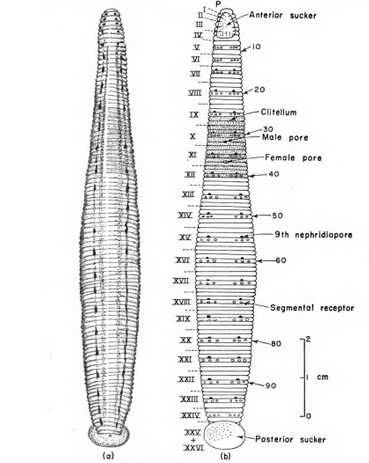 |
| Figure 6. Illustration of typical Hirudinidae external body plan. Retrieved from Mann, 1962. |
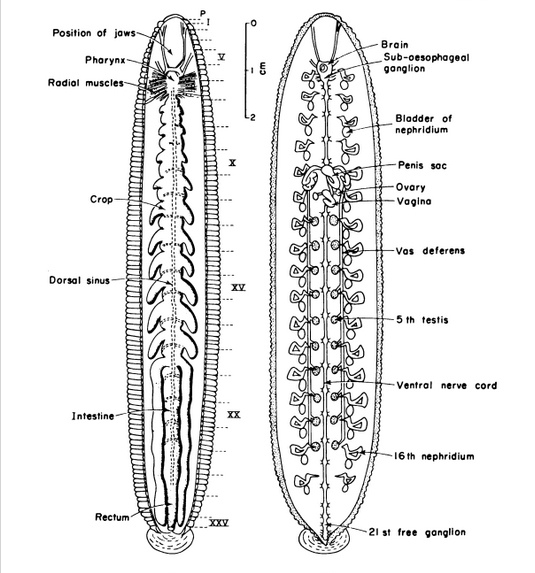 |
| Figure 7. Illustration of typical Hirudinidae internal body plan. Retrieved from Mann, 1962. |
Locomotion
The leech generally moves by anchoring its posterior sucker on a surface, extending its body in the direction of movement, anchoring its anterior sucker, and then pulling the rest of its body towards its anterior sucker.Most of you might not know this but the leech is also capable of 'swimming'. It does this by flattening itself in a dorsal ventral manner and moving in an undulating manner - as would a snake.
Reproduction
Hirudinaria manillensis is a hermaphrodite - it possesses both the male and female reproductive organs. The Hirudinidae have an eversible penis and is inserted into the vagina of another leech during mating. Reciprocal fertilisation is possible if both take up a head-to-tail position. However, unilateral action is probably more usual. Unfortunately, other than that, very little is known about its reproductive behaviour [6].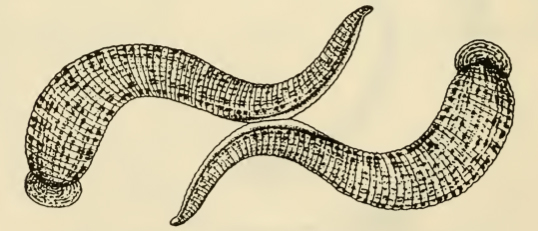 |
| Figure 8. Cross fertilization of Hirudinidae. Retrieved from Mann, 1962. |
Medicinal uses
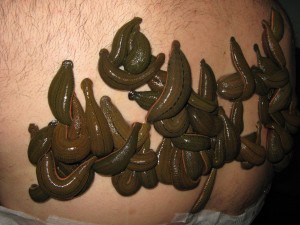 |
| Figure 9. Leech therapy using Hirudinaria manillensis. Retrieved from www.leechtherapy.org |
The use of medicinal leeches in phelebotomy - blood letting - has been recorded 3000 years ago in ancient Egypt. It was subsequently spread through Greece, Rome, Arab, Asia, and Europe. It was believed to be one of several remedies to restore the balance of the four humours - blood, phelgm, choler (identified with bile, and associated with a peevish temperament), and melancholy. It was also a form of counter-irritatant, applied to counteract the effect of a disease that irritates the skin or gut [1]. The use of medicinal leeches for phelebotomy reached its peak in 19th century Europe. Today, phelebotomy is primarily used in western medicine for a few conditions, such as hemochromatosis, polycythemia vera, and porphyria cutanea tarda, due to a better understand of physiology and advancements in medicine [5]. Hirudo medicinalis was heavily harvested and farmed in the past centuries as a panacea for all ailments. Now, it is classifed as being near threatened in the IUCN red list. Alternatives like the Hirudo verbana and Hirduinaria manillensis are being used as substitutes for the ancient practice today - due to their lower cost [1]. Although a dying practice, leech farming still exists in Europe today. However, the import of other leeches, specifically Hirudinaria manillensis, is more common [1]. Malaysia also has programmes to farm leeches for medical/commercial purposes. Everlive agrofarm, under the MAHE group, is one such example. Nooraini's Leech Therapy House is a clinic that provides leech-specific treatments in Singapore.
Notable proteins
Hirudin, a blood anti-coagulant, is a naturally occurring protein formed in the salivary glands of medicinal leeches [2].
Its main function is to inhibit the procoagulant activity of thrombin, which causes the conversion of fibrinogen into fibrin. Hirudin is the most potent natural inhibitor of thrombin. Unlike antithrombin, which is found in normal human blood circulation, hirudin binds to and inhibits only the activity of thrombin, with the specific activity on fibrinogen [2].
Hirudin, therefore, has therapeutic value in blood coagulation disorders, the treatment of skin hemtomas and of superficial varicose veins. Hirudin also has some advantages over more commonly used anticoagulants as it does not interfere with the activity of other serum proteins, and can also act on complexed thrombin [8].
Hirudin is also being artificially and chemically altered to form several other direct thrombin inhibitors [2][3][8].
Phylogeny
Figure 10 is the result of one of the very few phylogenetic analyses involving Hirudinaria manillensis. Although it is not very informative with regard to the rest of Annelida, it gives some perspective of its placement within Hirudinidae. Most importantly, it supports the monophyly of Hirudinaria manillensis. The phylogenetic analysis was performed using fragments of the mitochondrial Cytochrome oxidase 1 gene containing 658 base pairs. The tree topology was estimated using Maximum Likelihood(ML) and Bayesian Inference(BI) analyses. Both gave identical topologies with high support for all major nodes (ML bootstrap values of 99-100% and BI bipartition posterior probability of 1) as can be seen in the figure. |
| Figure 10. Phylogeny within Hirudinidae. Retrieved from Tubtimon et al., 2014. |
Anecdotal information
The following observations are not scientifically verified;Hirudinaria manillensis does not seem to be attracted to blood, but instead to movement within its subsiding water body.
They seem to be able to survive without being fed for up to six months.
References
[1] Elliott J. M., Kutschera U., 2011. Medicinal leeches: historical use, ecology, genetics, and conservation. Freshwater Reviews 4: 21-44.[2] Fenton J. W., Villanueva G. B. Ofosu F. A., Maraganore J. M., 1991. Thrombin inhibition by hirudin: How hirudin inhibits thrombin. Haemostasis 21: 27-31.
[3] Fenton J.W., Ofosu F.A. et al., 1998. Thrombin and antithrombiotics. Haemostasis 24: 87-91.
[4] Kutschera U., Roth M., 2006. Notes on the ecology of the asian medicinal leech Hirudinaria manillensis. Lauterbornia 56: 9-13
[5] Lee GR, Foerster J, Lukens J, et al. Wintrobe’s Clinical Hematology. 10th ed. Baltimore, MD: Williams & Wilkins; 1999:1063,1079,1539
[6] Mann K. H., 1962. Leeches (Hirudinea): Their structure, physiology, ecology, and embryology. Pergamon Press, New York.
[7] Philips A. J., 2012. Phylogenetic placement of a new species of Asian buffalo leech , and confirmation of human-mediated dispersal of a congener to the Caribbean. Invertebrate Systematics 26: 293-302.
[8] Rydell T. J., Tulinsky A. et al., 1991. Refined structure of the Hirudin-Thrombin complex. Journal of Molecular Biology 221: 583-601.
[9] Tubtimon J., Jeratthitikul E., Sutcharit C., Kongim B., Panha S., 2014. Systematics of the freshwater leech genus Hirudinaria Whitman, 1886 (Arhynchobdellida, Hirudinidae) from northeastern Thailand. ZooKeys 452: 15-33.
[10] Wu S. K., 1981. The leeches of Taiwan Part 2. Hirudinaria manillensis (Lesson). Quarterly Journal of the Taiwan Museum 34: 207-211.